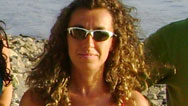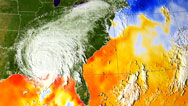Earthquakes in the Midwest
- Posted 09.01.09
- NOVA scienceNOW
(This video is no longer available for streaming.)
Scientists have a good idea of what causes earthquakes like those that struck Chile or Haiti in 2010, or in places like California. It's all about sudden movement along the edges of the giant crustal plates that make up the Earth's crust. But another kind of quake exists, one that occurs far from plate boundaries. It's big, it's dangerous, and it could strike anytime in the very middle of America.
Transcript
Earthquakes in the Midwest
PBS Airdate: September 1, 2009
NEIL DeGRASSE TYSON: We've got a pretty good idea of what causes earthquakes in places like California. It's all about movement along the big cracks in Earth's crust. North America is part of a giant rigid plate of crust moving this way, and the Pacific Ocean sits on another plate moving this way. Most of the time, the edges are just kind of stuck together, but every now and then, the tension gets too high...boom! The edges slip; you get an earthquake.
So you might think, "Hey, if I just stay away from here, I can avoid the big shake up."
But not so fast. As correspondent Peter Strandring reports, they're now realizing that there's another kind of quake. It's big, it's dangerous, and it could be headed straight for the middle of America.
PETER STANDRING: Sam Panno is on the hunt. He's looking for evidence, hidden deep inside a cave in Illinois. There's over 14 miles of wet, slippery, bat-filled tunnels down here.
After hours of hiking, he spots what he's come for.
SAM PANNO (Geochemist, Illinois State Geological Survey): Looks good.
PETER STANDRING: These lumps of rock might not look like much, but for Sam, they could help answer a frightening question: "Is the American heartland about to be hit with a cataclysmic earthquake?"
When I think earthquake, I think California, the San Andreas Fault and fears of "the big one." And that makes sense, because most big earthquakes happen in places like California, where big plates of the earth's crust collide with each other. But if you ask the experts, they'll say one of the biggest looming earthquake threats in the US is far from California. In fact, it's here, in Memphis, Tennessee.
It's Saturday night, and the crowds on Beale Street seem pretty, well, carefree. But about 200 years ago, the entire region was rocked by enormous earthquakes, and experts like Gary Patterson say Memphis has something to worry about.
So here we are on Beale Street on a Saturday night, and, obviously, the place is packed. From what I understand, luckily, Memphis didn't exist when the big quakes were happening in 1811 and 1812.
GARY PATTERSON (University of Memphis): That's right. We didn't have instruments in the ground, but we know they were really big. They really happened and they could really happen again.
What happened was that the midwest was hit by not one, but three epic earthquakes, with epicenters somewhere near the town of New Madrid, Missouri.
According to eyewitnesses, parts of the Mississippi River changed direction.
TISH TUTTLE (U.S. Geological Survey): Geysers of water and sand went shooting into the air. Fissures were forming in the ground. Some of them were so large that they were afraid they'd be swallowed up by them.
PETER STANDRING: In fact, one report claimed eight Indians were killed by the opening and shutting of the earth.
There weren't any big cities in the region, and no one knows how many people died, but the tremors were so strong, they were felt from Mexico to Canada, over a thousand miles away.
How is it possible that some of the biggest quakes in American history would strike in the middle of the continent, where there are no visible faults, and away from the plate boundaries?
GARY PATTERSON: It's an enigma. It's, it's, it's a, it's a puzzle.
PETER STANDRING: To help solve the mystery, geologists are trying to uncover the truth of what happened here in the past. And that's why I joined geologist Sam Panno and his team on their little cave adventure, to track down rocks that bear the imprint of ancient earthquakes.
And I expect we're going to get muddy?
SAM PANNO: A little bit.
PETER STANDRING: If we want to find the right rocks, it turns out we need to go underground, and we need to get a little wet.
Hey, Sam, I guess that trail of popcorn that I dropped behind us isn't going to do us any good at this stage.
SAM PANNO: I guess not.
PETER STANDRING: Lucky for me, Sam knows his way around these tunnels, all 14 miles worth. He's been trekking through midwestern caves for years, on the hunt for stalagmites, those spikes of rock that grow up from the cave floors.
Since they build up gradually, from minerals dripping from above, each stalagmite carries a unique geological record, sometimes stretching back tens of thousands of years.
If earthquakes happened here, the stalagmites will prove it.
SAM PANNO: Stalagmites grow layer upon layer.
PETER STANDRING: Break a stalagmite in half, and you can see rings of growth, kind of like tree rings.
SAM PANNO: You have the youngest rings on the outside, the oldest ring on the inside.
PETER STANDRING: So a stalagmite like this one, for example, may have taken tens of thousands of years to grow to that height?
SAM PANNO: That's about right.
PETER STANDRING: For years, Sam has been taking samples of these rocks to hunt for signs of earthquakes hidden in their crystal rings.
Back in the comfort of a warm, dry lab, the collection starts to tell a story.
BRUCE FOULKE: That one layer would have been a split.
PETER STANDRING: Bruce Foulke, at the University of Illinois, studies the rocks Sam gathers. Even the rough shape can reveal past earthquakes.
BRUCE FOULKE: You can see that the outermost layer here is shifted. Instead of growing here, it's moved down and shifted off to here. The reason that's happened is the stalagmite is growing from a point source of water that's dripping, dripping, dripping. Then we had earthquake activity, and the position of the drip moved.
And now the new drip started accumulating and growing a new stalagmite in this position, which is down and off the shoulder of the old stalagmite.
PETER STANDRING: Whenever they spot a shift like this, the team cuts a paper thin slice of stalagmite. With a powerful microscope, Bruce can isolate individual crystal layers...
BRUCE FOULKE: Wow.
PETER STANDRING: ...and see exactly where the earthquake happened.
BRUCE FOULKE: That specific line is represented here on the microscope screen by this dark area of crystal growth.
PETER STANDRING: To date the earthquake, they don't count the rings like you do with tree rings. Instead, high precision chemical analysis of the crystals reveals how long ago they formed.
When the results for this stalagmite came back, the team discovered that this major shakeup dates to about 200 years ago, a remnant of the great quakes of 1811 and 1812.
And with other samples they've gathered, the team has uncovered more.
In fact, the rocks reveal a pattern of violent midwestern earthquakes stretching back at least 15,000 years. The 1811, 1812 quakes weren't a freak one-time event. And if they happened many times before, then they will probably happen again.
The big question is when.
Today, the whole region, called the New Madrid Seismic Zone, is carefully monitored by seismic sensors. It turns out the ground here is shaking almost every day.
GARY PATTERSON: We have about 200 small earthquakes per year, 90 percent of those too small to be felt by humans. It's the most active seismic zone east of the Rockies.
PETER STANDRING: So why is the midwest made of such shaky ground when there are no visible faults on the surface?
According to one theory, it's because the region lies over an ancient wound, deep down in the earth's crust.
GARY PATTERSON: Half a billion years ago, the North American continent was being pulled apart by plate tectonic forces. And it created a rift.
PETER STANDRING: But at some point, the continent stopped breaking up.
GARY PATTERSON: For some reason, that rift failed.
PETER STANDRING: The failed rift created a weak spot in the crust, which might make the region more vulnerable to quakes, but no one really understands how.
To try to get a better picture of what might be going on, Beatrice Magnani is probing the earth's crust beneath the Mississippi River.
Chugging along in a tugboat, her team sends powerful sound waves down through the water, and a mile deep into the earth's crust. As the sound waves bounce back, they're picked up by dozens of small microphones trailed by 80 yards of cable in the river.
The echoes reveal distinct layers of sediment.
BEATRICE MAGNANI (University of Memphis): Reading the sediments is like reading a book. The sediments tell us the story of what happened with time.
PETER STANDRING: What happened was these layers became deformed and folded by major earthquakes.
But as Magnani discovered, these folds were outside the currently active New Madrid Seismic Zone.
BEATRICE MAGNANI: Nobody knew about these faults. It's actually a discovery that...it's even more puzzling than not finding anything.
PETER STANDRING: For Magnani, it means that over the eons, the danger zone in the midwest may jump from one area to another, which makes it even more difficult to predict future big earthquakes in an area that is underprepared.
This city wasn't even founded until seven years after the great earthquakes of 1811 and 1812, so it's hard to imagine what would happen if something of the same magnitude occurred in this region today.
If the 1811 and 1812 quakes are repeated, they will affect much more than Memphis, but also the entire region stretching to the north, including St. Louis.
GARY PATTERSON: A huge area would be affected, possibly an area containing 12 million people. There're a lot of old buildings.
PETER STANDRING: Whenever it happens, the next big midwestern earthquake is guaranteed to be catastrophic, destroying billions of dollars in property, and affecting millions of lives.
Yet, unlike Californians, many people here remain unaware that their cities and towns stand on potentially very shaky ground.
On Screen Text: A few theories throughout history explaining earthquakes: Aristotle thought violent winds trapped underground. Two millennia later, the Enlightenment prompted new theories: lightning, really strong lightning or maybe subterranean chemical reactions. And our current theory? Giant chunks of Earth rubbing against each other; we'll see how long this one lasts.
Credits
Earthquakes in the Midwest
- Edited by
- Dick Bartlett
- Produced by
- Arun Rath and Julia Cort
NOVA scienceNOW
Joey David Jovanovich
Mandy Minichiello
Laura Raimondo
Tung-Jen (Sunny) Chiang
Jonathan Loewald
Anthony Manupell
i Jeff Marion
Cass Sapir
Laura Willcox
Austin de Besche
Joe Brunette
Brian Dowley
Charlie Macarone
Pete Nenortas
John Park
Len Schmitz
Dennis Sprankel
John van der Does
Darcel Walker
- Executive Producer
- Kirk Wolfinger
- Production Manager
- Donna Huttemann
- Three dimensional brain animation
- Courtesy Dr. Arthur W. Toga, Laboratory of Neuro Imaging at UCLA.
- Archival Material
-
America By Air
American Antiquarian Society
BBC
Larry Burrows Estate
Wade B. Clark Jr.
Corbis
Friedman Archives
ITN
Jan Kozak Collection, NISEE, University of California, Berkeley
Korean Broadcasting System
KRON4
Utako Kikutani
National Geographic
Oxford Scientific (OSF)
Craig Skelly
Streamline Films
Adam Zoghlin, Timelapse.com - Special Thanks
- Comunidad Inti Wara Yassi
Yoon Jingyu
KBS
Andy Lee
Craig Lundstrom
Sharon O'Guin, Memphis Film & Television Commission
Penn State University
Eric Sargis
Eugene Schweig, USGS
Jon Shivers, Performa Entertainment
University of Florida
John Vergos
Yale University - Neil deGrasse Tyson
- is director of the Hayden Planetarium in the Rose Center for Earth and Space at the American Museum of Natural History.
- NOVA Series Graphics
- yU + co.
- NOVA Theme Music
- Walter Werzowa
John Luker
Musikvergnuegen, Inc. - Additional NOVA Theme Music
- Ray Loring
Rob Morsberger - Post Production Online Editor
- Spencer Gentry
- Closed Captioning
- The Caption Center
- NOVA Administrator
- Mykim Dang
- Publicity
- Carole McFall
Eileen Campion
Victoria Louie
Karinna Sjo-Gaber
Karen Laverty - Marketing
- Steve Sears
- Researcher
- Kate Becker
- Senior Researcher
- Gaia Remerowski
- Production Coordinator
- Linda Callahan
- Paralegal
- Sarah Erlandson
- Talent Relations
- Scott Kardel, Esq.
Janice Flood - Legal Counsel
- Susan Rosen
- Production Assistant
- Ryan Murdock
- Post Production Assistant
- Darcy Forlenza
- Associate Producer, Post Production
- Patrick Carey
- Post Production Supervisor
- Regina O'Toole
- Post Production Editors
- Rebecca Nieto
Jason York - Post Production Manager
- Nathan Gunner
- Compliance Manager
- Linzy Emery
- Development Producer
- Pamela Rosenstein
- Business Manager
- Joseph P. Tracy
- Senior Producer and Project Director
- Lisa Mirowitz
- Coordinating Producer
- Laurie Cahalane
- Senior Science Editor
- Evan Hadingham
- Senior Series Producer
- Melanie Wallace
- Managing Director
- Alan Ritsko
- Senior Executive Producer
- Paula S. Apsell
This material is based upon work supported by the National Science Foundation under Grant No. 0638931. Any opinions, findings, and conclusions or recommendations expressed in this material are those of the author(s) and do not necessarily reflect the views of the National Science Foundation.
NOVA scienceNOW is a trademark of the WGBH Educational Foundation
NOVA scienceNOW is produced for WGBH/Boston by NOVA
© 2009 WGBH Educational Foundation
All rights reserved
- (map) Adapted from Open-File Report 2008–1128, U.S. Department of the Interior, U.S. Geological Survey
Participants
- Bruce Fouke
- University of Illinois, Urbana-Champaign
- Beatrice Magnani
- University of Memphis www.ceri.memphis.edu/about_us/faculty/magnani.html
- Gary Patterson
- University of Memphis www.ceri.memphis.edu/about_us/students/patterson.html
- Peter Standring
- Correspondent
- Tish Tuttle
- U.S. Geological Survey mptuttle.com/mtuttlecollabs.html
Related Links
-

Find the Tectonic Fault
In this seismic image, see if you can locate an unsettling new fault just discovered beneath the Mississippi River.
-

Midwest Earthquakes: Expert Q&A
Geophysicist Beatrice Magnani answers questions about the New Madrid Seismic Zone and its deadly potential.
-

Hurricane Katrina: Expert Q&A
Research meteorologist Marshall Shepherd answers questions about hurricanes and the ongoing threat to New Orleans.
-

Stronger Hurricanes
Is global warming making hurricanes more intense?
-

Mt St Helens: Back From the Dead
Thirty years after the massive eruption, could it happen again?



